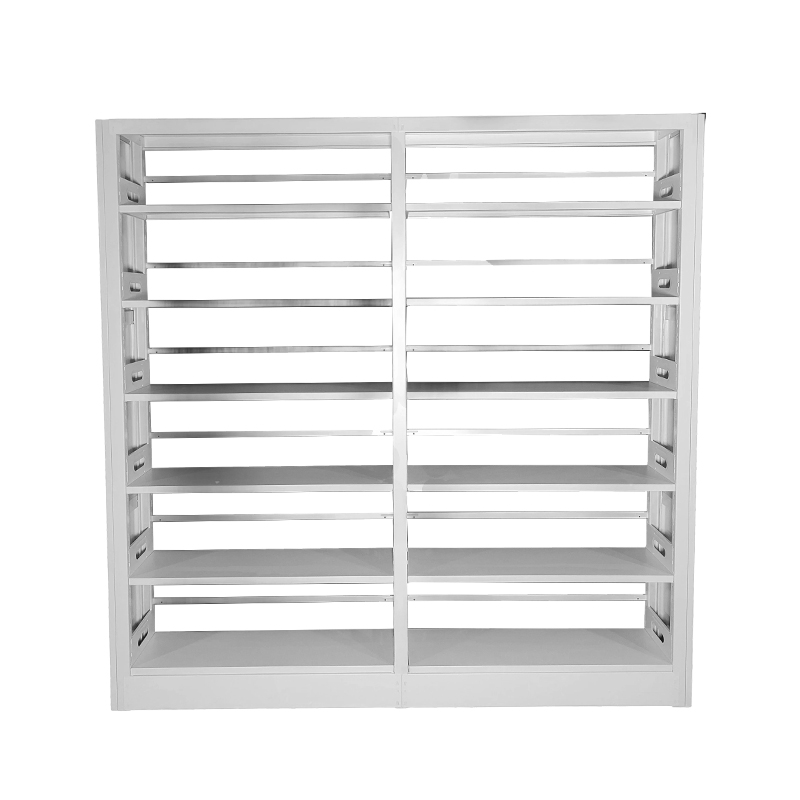How can the stability of compact shelves be guaranteed when moving on sloping ground?
Release Time : 2025-11-20
The stability of compact shelves on sloping ground requires a multi-dimensional design approach. The core logic lies in offsetting the instability caused by the slope through structural compensation, power control, and intelligent adjustment. The following analysis focuses on three aspects: mechanical structure, power system, and intelligent control.
The stability compensation design of the mechanical structure is fundamental. The cabinet chassis must be made of high-strength alloy steel or cold-rolled steel plate, forming an integral frame through segmented welding to ensure no deformation under pressure on the sloping ground. The track system must use wear-resistant, high-precision steel, and be calibrated with a laser level during installation to ensure that the track straightness error is controlled within a minimal range, preventing lateral forces caused by track deviations during cabinet movement. For example, some designs include adjustable support feet under the tracks, with height adjustments via threaded knobs to compensate for the ground slope and keep the tracks level. Additionally, widened casters or anti-slip rubber pads can be installed at the bottom of the cabinet to increase the contact area with the ground, improve friction, and prevent slippage.
Precise control of the power system is a crucial element. In manual mode, the transmission system requires a high-precision gear and chain combination to ensure even power transmission and prevent cabinet swaying due to gear backlash or chain looseness. In electric mode, the motor must be equipped with a closed-loop control system that monitors the cabinet's speed and position in real time via an encoder. When speed fluctuations caused by a tilted surface are detected, the output torque is automatically adjusted to maintain a constant speed. For example, some smart cabinets employ a dual-motor drive design, with independent control of the left and right motors. By comparing the speed differences between the two sides, the power output is dynamically adjusted to prevent the cabinet from shifting due to excessive force on one side. Simultaneously, the braking system must have rapid response capabilities. When manual or electric operation stops, an electromagnetic brake or mechanical locking device immediately intervenes to prevent the cabinet from continuing to slide due to inertia.
Dynamic adjustment of the intelligent control system is key to improving stability. The cabinet can integrate tilt sensors and accelerometers to monitor the ground tilt angle and cabinet movement status in real time. When the tilt angle exceeds the safety threshold, the intelligent system automatically triggers a protection mechanism: in manual mode, it alerts the operator to slow down or stop via voice prompts or light alarms; in electric mode, it directly reduces the motor speed or even pauses movement until the tilt angle returns to a safe range. Furthermore, the intelligent system can learn ground tilt characteristics based on historical usage data, predicting and adjusting movement strategies in advance. For example, on frequently used tilt routes, the system records the optimal movement speed and cranking force, automatically matching parameters the next time it passes over the same route, reducing the tediousness of manual adjustments.
Adding auxiliary devices can further enhance stability. For example, a retractable support rod can be installed on the top of the cabinet. When the cabinet moves to the designated position, the support rod extends downwards to touch the ground, forming a triangular support structure to distribute the cabinet's weight and reduce the risk of tilting. Some designs also install anti-tipping hooks on both sides of the cabinet. When the tilt angle is too large, the hooks automatically pop out, hooking onto the track or fixed bracket to prevent the cabinet from tipping over. In addition, a load balancing system can be installed inside the cabinet. Pressure sensors monitor the load-bearing capacity of each shelf. When a local overload occurs, the intelligent system prompts an adjustment of the item distribution to prevent instability caused by a shift in the center of gravity.
Proper use and maintenance are equally important. Before installation, the floor must be thoroughly cleaned to ensure it is free of debris and uneven surfaces. If necessary, anti-slip mats should be laid or the cabinet position adjusted. Regularly check the wear and tear of the tracks, wheels, and transmission components, replacing worn parts promptly, and lubricating key connections to reduce movement resistance. During operation, follow the principle of "gentle rocking and slow movement," avoiding excessive force or rapid starts to reduce the impact of inertia on stability. Through the synergistic effect of mechanical compensation, power control, intelligent adjustment, and standardized maintenance, compact shelves can move stably on inclined surfaces, meeting the needs of use in complex environments.





